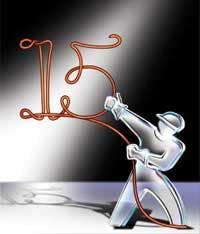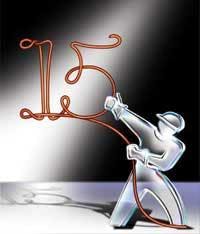by Patrick McLaughlin
The future is murky, but is the past crystal clear?
Fifteen years ago, this magazine was closing out its first year of publication. We have taken the liberty in this, the final printed issue of our 15th-anniversary year, to self-congratulate a little bit on our front cover. According to modern convention, the 15th anniversary is considered the "crystal" anniversary. So, we have had a little fun with words too, in the subheadline to this article.
If you will indulge me for the next couple of pages, I'd like to offer some personal reflections on the 11 years I have spent with Cabling Installation & Maintenance. As for the publication's first four years, well, as usual, I'll pretty much make that part up and pretend like I know what I'm talking about.
In 1993, the cabling industry could almost be defined by a single phrase: Cat 5. Category 5 unshielded twisted-pair cabling was the wonder drug. It capably handled the 100Base-Tprotocol, and soon both the protocol and the medium were nearly ubiquitous. Significant space in our lastissue was devoted to the history and future of the twisted-pair interface (see "Twisted-pair connectors continue technological evolution," November 2008, page 15), so I won't simply re-hash that all here. But as a point of historical reference, Category 5 reigned supreme when this title came into existence more than 15 years ago.
Wowed by GbE
By the time I arrived on the scene in 1997, the Cate-gory 5 situation had gotten less cut-and-dry than it had been a few years earlier. At the first BICSI conference (www.bicsi.org) I attended in June 1997, attendees were glued to their seats for a presentation on the comingprotocol Gigabit Ethernet. Now I have to admit, the audience's palpable interest level was what I remember most about that presentation because I had not the vaguest idea what Geoff Thompson, chair of the 802.3ab Task Force, was talking about. In fact, my supervisor noticed that during several of the presentations made that day, I was not taking notes. He asked me why I wasn't and I had to be honest. "I was waiting to hear some words I understood, and I would write those down," was my answer. Consequently, my notebook included the following words and phrases: the, difficult, closet, patch cord. At least I knew what a patch cord was.
The real point, though, is that even at that time I understood Gigabit Ethernet would be a tectonic shift for the industry. In retrospect, I still hold the opinion that it has been the single biggest technological development, with the farthest and deepest implications, of the last 15 years (and perhaps longer). From a technology standpoint, Gigabit Ethernet put twisted-pair copper cabling and multimodefiber-optic cabling through the proverbial wringer.Ultimately, we learned that some but not all installedCategory 5 cabling systems would support GbE, andthat 50-µm multimode fiber would support the protocol for greater distances than would 62.5-µm multimode.
Those conclusions shifted user preferences for media, and more significantly in my eyes, allowed standards makers within the Telecommunications Industry Association (TIA; www.tiaonline.org) to put a stake in the ground concerning what can actually be called a Category 5e cable. Originally a marketing term, Category 5e (which sometimes had a capital "E") became a bona fide set of performance specifications for twisted-pair cabling systems. Today, it is the minimum performance grade recognized by TIA standards, with the once-ubiquitous Category 5 nowrelegated to "annex" status.
Skip ahead several years (which we must when we haveonly two pages to play with), and the development of 10-Gigabit Ethernet similarly stressed twisted-pair cabling systems. As 2008 comes to a close, we are in the midst of the results of that stress. Specifically, Category 6A cabling is now a standardized set of performance specifications, likely someday to unseat its predecessor Category 6 as the twisted-pair medium of choice for users who foresee ultra-high-speed communication systems in their future. As for whether that Category 6A system is unshielded, foiled/unshielded, foiled/shielded, or someother construction, well, I guess that's the type of question that may keep us reporting for the next 15 years.
For multimode fiber systems, 10-GbE's development had relatively little fallout compared to what 1-GbE brought. Users today must be familiar with the "OM" nomenclature of multimode optical fiber. Specifically, OM3 fiber is the ideal medium for carrying 10-GbE to distances that can support an enterprise/campus-type environment. But the path from Gigabit to 10-Gigabit was a smoother one for optical than it was forcopper-based transmission systems.
Bandwidth debate looms
The technological path to 100-GbE might prove to be a different story. Over the past few issues of Cabling Installation & Maintenance (and let me warn you, it will happen forseveral of the upcoming issues as well), technical arguments have been made about the qualities of an optical fiber necessary to support 100-GbE. To me, these discussions are reminiscent of the 1-GbE situation more than a decade ago. Then, we heard for the first time, about phenomena such as differential mode delay. Now, expect to hear much debate aboutthe importance of effective modal bandwidth—and, I have to think, a few other head-scratching terms that will make me feel like I'm once again listening to Geoff Thompsonand understanding very little.
Also, in the near-term future, it will be interesting to see some early adopters of Category 6A systems who also will be early adopters of 10GBase-T put those pre-standard cabling systems to the test. It's likely that immediately, 10GBase-T links will largely be physically separated from each other and, therefore, not tempt the sleeping giant of alien crosstalk. In many cases, 10GBase-T deployments will be single runs within a computing environment, or perhaps multiple runs in different directions. But as 10GBase-T connections become more common and, therefore, closer in proximity to one another, those early-installed Category 6A cabling systems will prove their true value.
But 10GBase-T is not the only application set to verify the capabilities of twisted-pair copper cabling in the years ahead. The predicted emergence of Internet Protocol as a pervasive enabling technology worldwide has some good-news/bad-news implications. The good news: All kinds of applications, from IP video to building-automation systems will rely on cabling, and most likely the installed base of twisted-pair wiring, for successful communication. The bad news: All kinds of applications, from IP video to building-automation systems willrely on cabling, and most likely the installed base of twisted-pair wiring, for successful communication. Maybe it's inappropriate to call that "bad" news, but it might be a reminder for some to know a cabling system's capabilities and limits.
Several of the devices that now regularly connect to an Ethernet/IP network via twisted-pair cabling also have thecapability to receive direct-current (DC) power via thePower over Ethernet (PoE) specifications set forth in theInstitute of Electrical and Electronics Engineers (IEEE) 802.3af standard. Although the specifications are called Power over Ethernet, they probably should be called Power over Ethernet Cabling, because the cables' conductors truly are the transport mechanism for the DC that powers the end device. And as progress continues on the PoE Plus 802.3at specifications, the twisted-pair medium has come under further scrutinyvis-a-vis its ability to capably carry faster Ethernet signalsand higher levels of DC power than ever before.
Lest we forget wireless communications, the forthcoming 802.11n specifications are promising/threatening to transport data at speeds far exceeding 100 Mbits/sec. Presumably, that means organizations will have to run Gbit-speed links to their wireless access points in order to avoid having the wired network act as a bottleneck for its wireless complement. But let's not presume anything. Beginning on page 11 of this issue,David Veneski of Fluke Networks delves into detail on therealities of the coming 802.11n.
So, there's my brief and oversimplified take on cabling technology's recent past and immediate future. If you have gotten this far, thanks. Now, please email me to let me know how wrong I have gotten it.
PATRICK McLAUGHLIN is chief editor of Cabling Installation & Maintenance. He can be reached at: [email protected]

